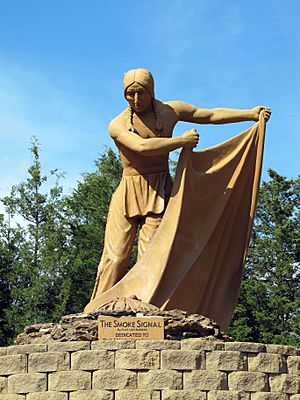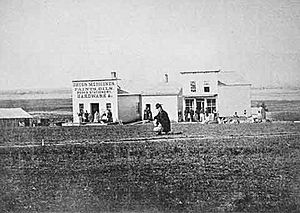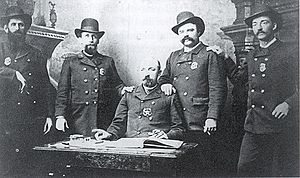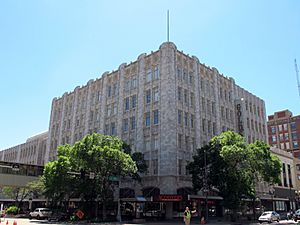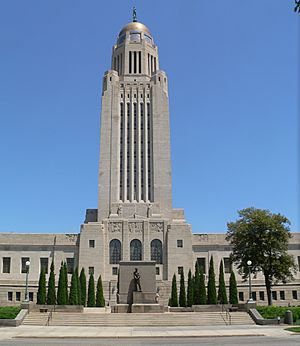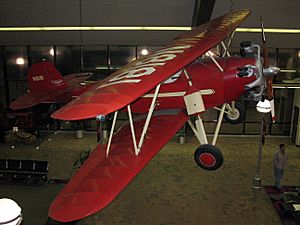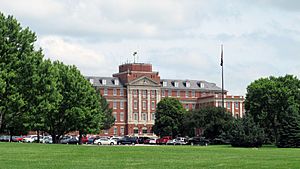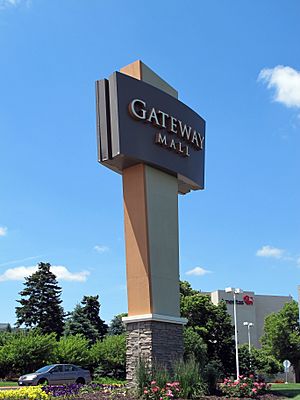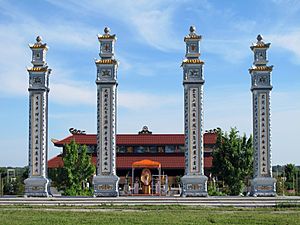History of Lincoln, Nebraska facts for kids
The history of Lincoln, Nebraska tells the story of how this important city grew. It started as a small village called Lancaster in 1856. The area was first home to Plains Indians who hunted along Salt Creek. Early settlers came to collect salt from the natural salt flats.
Nebraska became a state on March 1, 1867. A special group then chose Lancaster to be the new state capital. The village was renamed Lincoln, honoring Abraham Lincoln. The first State Capitol building was finished in 1868. Lincoln officially became a city on April 1, 1869.
By 1870, railroads started connecting Lincoln to other places. This helped the city grow into a major rail hub by 1892. In the early 1900s, many immigrants from Russia settled in Lincoln. The city also became part of major highways and had its first airport by 1920. By that time, Lincoln's population had grown to nearly 55,000 people.
In 1960, the Gateway Mall opened, drawing businesses away from downtown. To fix this, Lincoln began a big effort in 1969 to make the downtown area better. Helen Boosalis became Lincoln's first woman mayor in 1975. She strongly supported making Lincoln a welcoming place for refugees. In 1990, the U.S. Department of State officially called Lincoln a "Refugee Friendly" city. By 2010, Lincoln's population had reached over 258,000.
Contents
Early Days of Lincoln
Native Americans and First Settlers
Before settlers arrived, the land was covered in buffalo grass. Plains Indians had lived and hunted along Salt Creek for thousands of years. The Pawnee tribe lived in villages along the Platte River. The Great Sioux Nation, including the Lakota, used Nebraska for hunting. Sometimes, a wild buffalo could still be seen in Lincoln in the 1860s.
The first settlers were drawn to the area in 1856 because of the large amounts of salt. Salt was very important for preserving meat back then. People would boil the water from the salt flats to get more salt. However, once salt mines opened in Kansas, Lincoln's salt was no longer as valuable.
Founding the Village of Lancaster
The village of Lancaster was founded in 1856. It became the main town for the new Lancaster County in 1859. Captain W. T. Donovan and his family were among the first to settle near Salt Creek in 1856. Other settlers soon followed.
In 1859, the settlers decided to officially form a county. They chose Lancaster as the county seat. The village was quite small at first. After the Homestead Act of 1862, more people began to move in. A religious group led by Reverend John M. Young settled in Lancaster in 1863. Some people consider him the founder of what would become Lincoln.
Most settlers left the village in September 1864 because of fears of a Sioux Indian attack. However, the Pawnee Indians, who were friendly with the settlers, chased the Sioux away. Lancaster was saved, and settlers began to return in 1865.
Lincoln Becomes the Capital
The capital of the Nebraska Territory had been Omaha since 1854. But most people in the territory lived south of the Platte River. Many wanted to join Kansas. So, the territorial government decided to move the capital south and as far west as possible.
Before the vote, an Omaha senator tried to stop the move by suggesting the new capital be named after recently killed President Abraham Lincoln. Many people south of the Platte River had supported the Confederate side in the Civil War. The senator thought they wouldn't vote for a city named after Lincoln. But his plan failed, and the vote to move the capital passed.
Nebraska became a state on March 1, 1867. A special commission was formed to find a site for the capital on state land. They chose the village of Lancaster, partly because of its salt flats. Lancaster only had about 30 residents at the time. The commission created a new, larger plan for the city. Lancaster officially became Lincoln on September 6, 1867. To raise money, they sold land lots, and many new people arrived.
The first Nebraska State Capitol building was finished on December 1, 1868. It was a two-story building made of local limestone. The Kennard house, built in 1869, is the oldest building still standing from Lincoln's original plan.
Building a City
In 1867, Lincoln's first newspaper, the Nebraska Commonwealth, was started. By the end of 1868, Lincoln had about 500 people. In 1869, the University of Nebraska was founded in Lincoln. Construction on its first building began that same year. Lincoln officially became a city on April 1, 1869.
Railroads were very important for Lincoln's growth. The first train arrived in Lincoln on June 26, 1870. More railroads followed, and by 1892, Lincoln was a major railroad center.
In 1869, Wyuka Cemetery was created as a state cemetery. Its name comes from the Lakota language and means "to rest." The first police force was formed in July 1870. The State Lunatic Asylum, a hospital for mental health, opened in 1870 but burned down a year later. A new one was built in 1872. By 1888, it had nearly 400 patients.
The Lincoln Gas Light Company started in 1872. The U.S. Post Office and Courthouse was built from 1874 to 1879. The city public library opened in December 1875.

As Lincoln grew, stores began to open. Herpolsheimer's and Miller & Paine were the first department stores, both founded in 1880. Herpolsheimer's became a very large store, said to be the biggest west of the Missouri River. It closed in 1931 due to the Great Depression. Miller & Paine stayed in business until 1988.
The Lincoln Telephone Exchange started in 1880. City Water Works began in 1881. In 1885, Lincoln started a full-time paid Fire Department. The first hospital, Saint Elizabeth Hospital, was founded in 1889. It was the only general hospital in Lincoln until 1922.
In 1888, a new capitol building was built because the first one was not safe. This second capitol had a classical design. However, a worldwide economic downturn in the 1890s caused Lincoln's population to drop from 55,000 to 37,000 by 1900.
Lincoln in the 20th Century
Becoming a Modern City
In 1905, The Lincoln Star newspaper began. It later merged with The Nebraska State Journal in 1995 to become the Lincoln Journal Star. In 1915, William Gold's dry goods store became Gold and Company. It grew into a large, six-story department store known as Gold's.
As cars became popular, the need for better roads grew. In 1911, the Omaha-Lincoln-Denver Highway (O-L-D) was created. It aimed to be the best highway for travel across Nebraska. Construction and improvements began soon after. The O-L-D highway helped connect Lincoln to other cities.
In 1920, the Omaha-Denver Association joined with the Detroit-Lincoln-Denver Highway Association. The O-L-D was renamed the Detroit-Lincoln-Denver Highway (D-L-D). The goal was a continuous highway from Detroit to Denver, which was achieved by the mid-1920s. This 1,700-mile highway brought many tourists and businesses to towns along the way. In Lincoln, a tourist camp offered modern amenities for travelers. A "Public Comfort Station for Men" was built downtown as a rest stop. This building is now the Grand Manse Pavilion.
In the early 1900s, many Volga-German immigrants from Russia settled in Lincoln's North Bottoms neighborhood. As Lincoln grew, it began to add nearby towns. The first town annexed was Bethany Heights in 1922.
Construction on a third capitol building began in 1922. The previous capitol was unsafe. Bertram G. Goodhue was chosen as the architect. The first part of the new building was finished in 1924, and state offices moved in. The old capitol was torn down in 1925. The new capitol was built in phases and mostly finished by 1932.
In 1922, former United States Secretary of State William Jennings Bryan donated his home to create Bryan Memorial Hospital. The city also raised money to open Lincoln General Hospital in 1925. In 1929, Lincoln added the town of College View, where Union College was founded in 1891.
Growth and Expansion
In the early days of air travel, Lincoln had several airports. Union Airport was established in 1920. Charles Lindbergh learned to fly at the Lincoln Flying School in 1922. The flying school closed in 1947.
In 1924, the D-L-D highway became Nebraska State Highway 6. By 1926, it was part of the Federal Highway System and renamed U.S. Route 38. Later, in 1931, it became U.S. 6. This highway was once the longest national route in the U.S.
Arrow Airport was built around 1925 for making and testing planes. It closed decades later. An Arrow Sport plane is now on display at Lincoln Airport.
In 1930, a Veterans' Hospital opened. Lincoln also added the town of Havelock that year. By 1930, Lincoln's population had grown to 75,933.
The Lincoln Army Airfield was created in 1942. During World War II, over 25,000 aviation mechanics were trained there. The Army closed the base in 1945 but reopened it during the Korean War in 1952. In 1966, the base closed for good, and Lincoln took over the airfield. It became the Lincoln Municipal Airport, now known as Lincoln Airport.
In 1956, Bankers Life Insurance Company planned a large shopping center. The Gateway Mall opened in 1960 at 60th and O streets. It was an open-air mall with stores like Montgomery Wards and Miller & Paine.
Revitalization of Downtown
From 1959 to 1984, downtown Lincoln changed a lot as shopping moved to Gateway Mall. By 1984, most of Lincoln's sales tax money came from near the mall. Older movie theaters downtown were changed or closed.
One of the first parts of Interstate 80 in Nebraska connected Lincoln to Omaha in 1961. This made travel much faster.
In 1964, Gold's department store merged with Brandeis from Omaha. The Gold's name was eventually dropped, and the downtown store became Brandeis. Even though these big stores stayed open, fewer people visited downtown. Many restaurants and businesses closed or moved. This caused the downtown area to decline.
In 1969, Nebraska passed laws for urban renewal. Lincoln then started a program to improve and beautify the city, especially downtown. New streetlights were added. Important new buildings included the Sheldon Memorial Art Gallery and banks designed by famous architects.
In 1971, Gateway Mall expanded. Another big expansion happened in 1977. Brandeis opened a new store at the mall, closing its downtown location in 1980. Miller & Paine was bought by Dillard's in 1988, and its downtown store also closed.
Mayor Helen Boosalis, Lincoln's first woman mayor, was elected in 1975. She strongly supported making downtown beautiful. In 1979, the Centrum, a two-level shopping mall with a large parking garage, opened downtown. While these projects helped, many historic buildings were torn down.
After the fall of Saigon in 1975, many Vietnamese refugees came to Lincoln. They created a strong community with businesses along 27th Street. Lincoln was named a "Refugee Friendly" city by the U.S. Department of State. By 2000, Lincoln was one of the top places for refugee resettlement in the country.
The 1990s saw a huge increase in Lincoln's population. New homes and businesses were built, especially in south Lincoln. The Southpointe Pavilions shopping center also opened, competing with Gateway Mall. In 1995, the original open-air part of Gateway Mall was enclosed and expanded.
Lincoln in the 21st Century
After the dot-com bubble burst around 2000, Montgomery Ward closed all its stores, including the one in Gateway Mall. In 2001, Westfield America Trust bought Gateway Mall and renamed it. Westfield spent $45 million in 2005 to update the mall, adding a bigger food court and a new entrance.
In 2007 and 2009, Lincoln received grants to improve O and West O Streets. These improvements honored the history of the D-L-D highway.
In 2012, Starwood Capital Group bought Gateway Mall and changed its name back to Gateway Mall. They have continued to make small improvements. In 2014, the U.S. Post Office, which had been in the mall since 1968, moved to a new location nearby. Gateway Mall remains the largest mall in Lincoln.
In 2015, heavy rain caused Salt Creek to flood parts of the city. People in the North and South Bottoms neighborhoods were asked to leave their homes. The Antelope Valley Project helped keep water within Antelope Valley Creek. Lincoln Municipal Airport reported over six inches of rain.
Also in 2015, ALLO Communications announced plans to bring super-fast fiber internet to Lincoln. This would offer speeds up to 1 Gigabit per second for homes and businesses. Construction began in 2016 and was expected to finish by 2019. Windstream Communications also announced similar plans.
In 2023, part of the Gold's Building downtown was torn down to make way for a new hotel. The remaining northern part of the building will be turned into mixed-use spaces.
Panoramas


